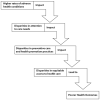Health disparities of adults with intellectual disabilities: what do we know? What do we do?
- PMID: 23913632
- PMCID: PMC4475843
- DOI: 10.1111/jar.12067
Health disparities of adults with intellectual disabilities: what do we know? What do we do?
Abstract
Background: Recent attention to health of people with intellectual disabilities has used a health disparities framework. Building on historical context, the paper summarizes what is known about health disparities from reports and research and provide direction on what to do to reduce these disparities among adults with intellectual disabilities.
Methods: The present authors examined literature from 2002 to 2011 on health disparities and people with disabilities looking for broad themes on documenting disparities and on research approaches and methods.
Results: Multiple countries published reports on health of people with intellectual disabilities. Researchers summarized existing research within a health disparities framework. A number of promising methodologies are identified such as health services research, health indicators, enhanced surveillance and mixed-methods.
Conclusions: Strategies to reduce health disparities include use of data to educate decision makers, attention to social determinants and a life-course model and emphasis on leveraging inclusion in mainstream services where possible.
Keywords: disparities; life-course model; social determinants.
Published 2013. This article is a U.S. Government work and is in the public domain in the USA.
Figures




References
-
- Allerton L, Emerson E. [accessed on 10 November 2012];Individuals With Impairments Face Significant Barriers to Accessing Health Services in the United Kingdom. Public Health. 2012 Available at: http://dx.doi.org/10.1016/j.puhe.2012.08.003) - DOI - PubMed
-
- American Association on Intellectual and Developmental Disabilities (AAIDD) Intellectual disability: Definition, classification, and systems of supports. American Association on Intellectual and Developmental Disabilities; Washington, DC: 2010.
-
- Asada Y. [accessed on 15 December 2012];A summary measure of health inequalities for a pay-for-population performance system. Preventing Chronic Disease. 2010 7 http://www.cdc.gov/pcd/issues/2010/jul/09_0250.htm. - PMC - PubMed
-
- Australian Institute of Health and Welfare . Disability in Australia: Intellectual Disability. AIHW; Canberra: 2008. AIHW bulletin no. 67. Cat. no. AUS 110.
-
- Balogh R, Brownell M, Ouellette-Kuntz H, Colantonio A. Hospitalization rates for ambulatory care sensitive conditions for persons with and without an intellectual disability –a population perspective. Journal of Intellectual Disability Research. 2010;54:820–832. - PubMed
Publication types
MeSH terms
Grants and funding
LinkOut - more resources
Full Text Sources
Other Literature Sources
Medical

